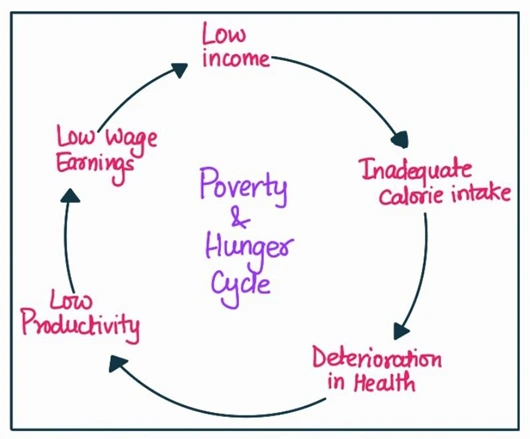Answer:
| Approach:
Introduction
- Introduce the growing divergence between poverty and hunger in India.
Body
- Discuss the trends in poverty and hunger in India, highlighting the divergence between the two.
- Explain the reasons for shrinking social expenditure, such as fiscal constraints and changing policy priorities.
- Discuss the impact of reduced social expenditure on the poor, focusing on the increased burden of non-food essential items like healthcare, education, and housing.
- Elaborate on how this increased burden on non-food essential items is squeezing the food budget of the poor, leading to increased hunger and malnutrition.
Conclusion
- Conclude, emphasizing the need for adequate social expenditure to ensure that the poor can access essential services and maintain a sufficient food budget.
|
Introduction:
India has witnessed a growing divergence between poverty and hunger, with the reduction in poverty rates not translating into a corresponding decrease in hunger levels. A key factor contributing to this divergence is the shrinking of social expenditure by the government, which forces the poor to spend more on non-food essential items, thereby squeezing their food budget.

Body:
- Poverty and hunger trends in India show a growing divergence. While poverty rates have declined significantly over the years, hunger levels remain stubbornly high, with India ranking poorly on global hunger indices. This indicates that economic growth and poverty reduction alone have not been sufficient to address the issue of hunger and malnutrition.
- According to the Global Hunger Index 2020, India ranks 94th out of 107 countries, indicating a serious level of hunger. The report highlights high levels of child wasting (low weight for height) and stunting (low height for age) in India, reflecting persistent malnutrition issues.
- Shrinking social expenditure by the government is one of the primary reasons behind this divergence. Fiscal constraints and changing policy priorities have led to reduced investments in essential social services like healthcare, education, and housing. This reduction in social spending has forced the poor to allocate a larger portion of their income to meet their non-food essential needs.
- A report by Oxfam India highlights that the country’s spending on health, education, and social protection as a percentage of GDP has been declining over the years. This reduction in social spending has disproportionately affected the poor, who often rely on public services for their basic needs.
- As a result, the poor are left with a smaller portion of their income to spend on food, leading to a squeezed food budget. This, in turn, results in inadequate access to nutritious food, exacerbating hunger and malnutrition among vulnerable populations.
Conclusion:
To address the growing divergence between poverty and hunger in India, it is imperative to ensure adequate social expenditure that enables the poor to access essential services without compromising their food budget. Investing in social services and social protection measures will not only help alleviate hunger and malnutrition but also contribute to more inclusive and sustainable development outcomes.
